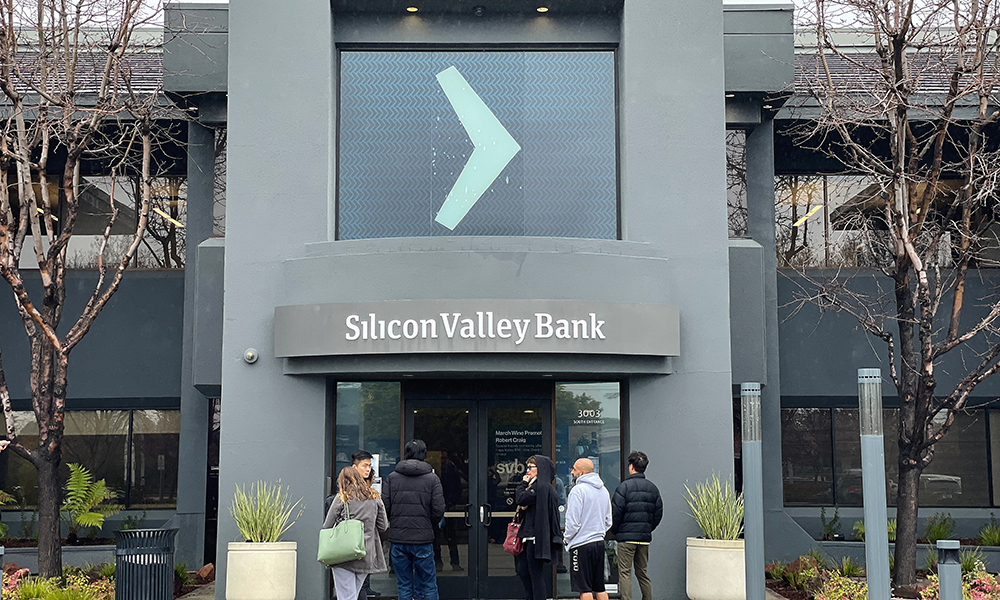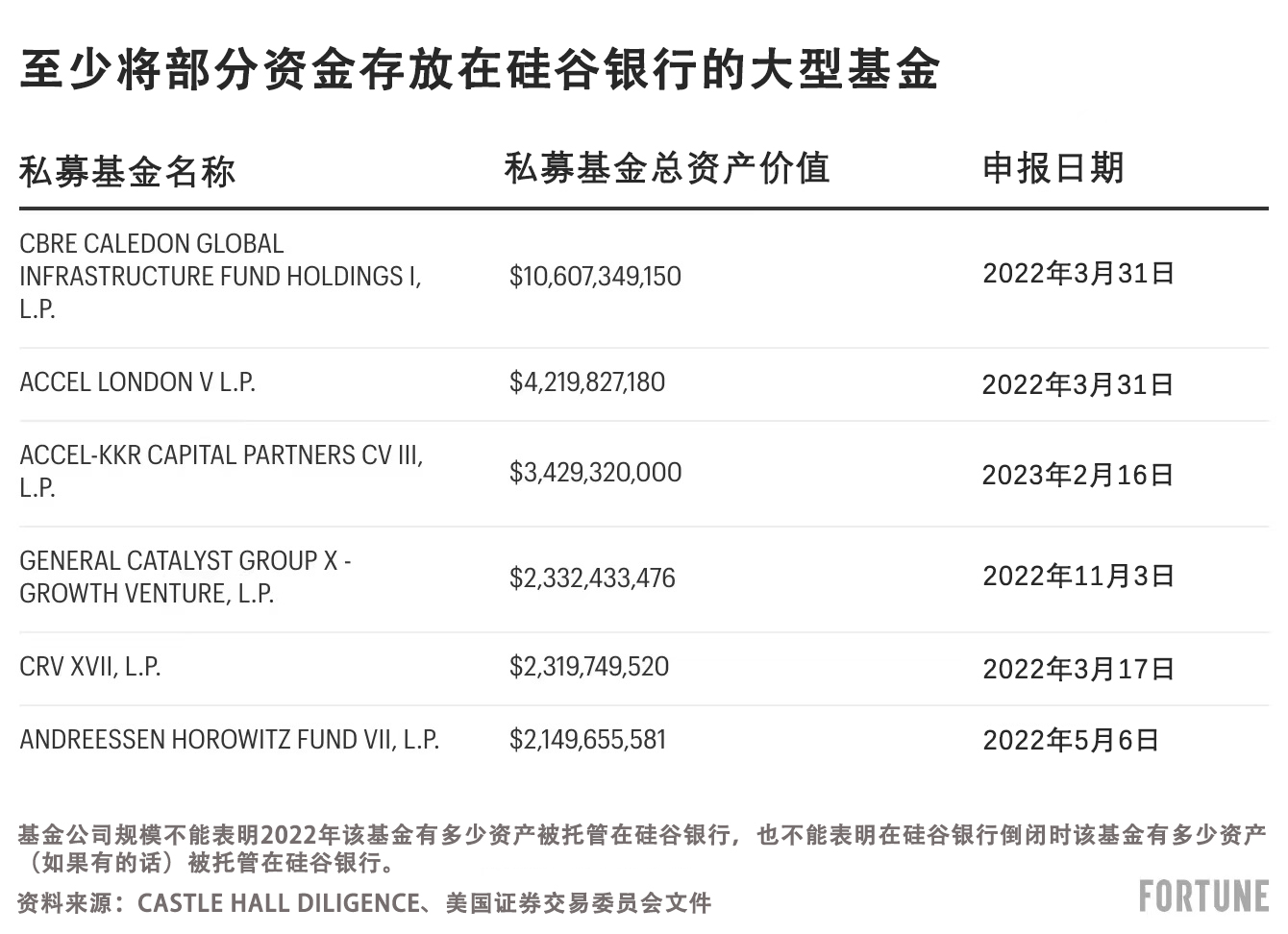文件显示,硅谷银行去年为1,074家公司托管资产

为大量初创公司提供银行服务的硅谷银行(Silicon Valley Bank)破产,使得初创公司创始人在未来几天或几周内都会为如何发工资而苦恼,但受硅谷银行破产波及的远不止初创公司。
《财富》杂志分析的新数据显示,硅谷银行是约50%初创公司的首选金融机构,近年来还为约1,074家私募股权和风险投资公司托管资产。
由Castle Hall Diligence根据美国证券交易委员会(SEC)公开的年度文件汇编的数据显示,截至2021年年底,包括安德森-霍洛维茨(Andreessen Horowitz)、General Catalyst、Accel和基准资本(Benchmark Capital)在内的1,074家私募股权和风险投资公司至少储存了5,994只基金的部分资产。这近6,000只基金的总资产为8,630亿美元,不过由硅谷银行托管的资产比例不得而知,而且这个数字要小得多。
虽然在美国证券交易委员会注册的风险投资公司或私募股权投资公司必须披露它们将各基金的资产储存在哪些银行,但它们无需报告有多少资金是专门储存在硅谷银行,而不是其他银行。而且,各公司每年只需要报告一次,因此,该分析是基于最新的可用数据,这意味着这些数据可能无法完全准确地反映每家公司在硅谷银行倒闭时的持有资产情况。
即便如此,这些数据还是反映了硅谷银行在私募市场的主导地位,不仅为私募基金提供贷款服务,还为风投公司提供托管服务。由于法律要求风险投资家将他们的基金资产“托管”在金融机构,他们使用“托管人”,即硅谷银行等银行来监控和保管资金,确保资金不被盗或丢失。当基金从有限合伙人那里调用资金时,托管人会一直持有这些资金,直到基金准备好如何布局——这意味着风险基金在银行的资金数额通常远低于基金在任何给定时间的整体规模。
“这份文件显示了硅谷银行的规模和足迹。”Castle Hall Diligence的创始人及首席执行官克里斯·阿迪表示。“将6,000只基金储存在相对较小的银行,这真的很独特——这种现象在债券、对冲基金或房地产领域是不存在的。”
硅谷银行是美国第16大银行,与美国银行(Bank of America)、摩根大通(JPMorgan Chase)等金融机构相比,规模相对较小。即便如此,它的客户群还是高度集中在初创公司和风投领域。数据显示,硅谷银行的客户群涵盖了所有顶级风险投资和私募股权公司,其中包括安德森-霍洛维茨、General Catalyst、Union Square Ventures、Thrive Capital、Two Sigma、Accel、基准资本、Seven Seven Six和Flybridge Capital Partners等1,000多家公司,涉及领域从房地产或基础设施投资者到Techstars等启动加速器。
现在出现的问题是,硅谷银行专注于这样一个特定的细分市场是否会导致负债——尤其是该银行在2021年风险投资热潮期间的投资于2022年出现了回落,之后随着利率开始攀升,硅谷银行的资产负债表出现严重问题。
阿迪称,整个行业都会对一个行业如此高度集中于一家金融机构的情况进行更细致的思考,因为很明显,在这种情况下,这不是一个好主意。
他说:“我认为这将引发很多问题,比如资金集中是如何出现的。”
《财富》杂志联系了上述几家风险投资和私募股权公司,但截至发稿前尚未收到回复。
虽然自2022年年初以来,一些风投公司可能已经开始使用其他银行提供的服务,但托管关系更改通常相当棘手,这是因为更改托管关系通常需要额外的成本,并可能暂时中断日常运营。然而,由于人们普遍担心硅谷银行可能会倒闭,一些风投公司可能已经在本周早些时候将资产转移到另一家托管机构。
目前,硅谷银行持有的所有资金都在美国联邦存款保险公司(Federal Deposit Insurance Corp.)的冻结之下。据彭博社(Bloomberg)报道,该机构已经启动了对硅谷银行的拍卖程序,最终报价将于周日下午截止。联邦存款保险公司表示,它将保证下周一所有受保存款客户全额获得存款资金,并在下周向未受保险覆盖的存款客户预先支付一部分利息,但目前尚不清楚支付的利息数额以及客户何时会收到利息。
根据最新提交给美国证券交易委员会的文件,以下是一些至少将部分资金存放在硅谷银行的大型基金:

(财富中文网)
译者:中慧言-王芳
为大量初创公司提供银行服务的硅谷银行(Silicon Valley Bank)破产,使得初创公司创始人在未来几天或几周内都会为如何发工资而苦恼,但受硅谷银行破产波及的远不止初创公司。
《财富》杂志分析的新数据显示,硅谷银行是约50%初创公司的首选金融机构,近年来还为约1,074家私募股权和风险投资公司托管资产。
由Castle Hall Diligence根据美国证券交易委员会(SEC)公开的年度文件汇编的数据显示,截至2021年年底,包括安德森-霍洛维茨(Andreessen Horowitz)、General Catalyst、Accel和基准资本(Benchmark Capital)在内的1,074家私募股权和风险投资公司至少储存了5,994只基金的部分资产。这近6,000只基金的总资产为8,630亿美元,不过由硅谷银行托管的资产比例不得而知,而且这个数字要小得多。
虽然在美国证券交易委员会注册的风险投资公司或私募股权投资公司必须披露它们将各基金的资产储存在哪些银行,但它们无需报告有多少资金是专门储存在硅谷银行,而不是其他银行。而且,各公司每年只需要报告一次,因此,该分析是基于最新的可用数据,这意味着这些数据可能无法完全准确地反映每家公司在硅谷银行倒闭时的持有资产情况。
即便如此,这些数据还是反映了硅谷银行在私募市场的主导地位,不仅为私募基金提供贷款服务,还为风投公司提供托管服务。由于法律要求风险投资家将他们的基金资产“托管”在金融机构,他们使用“托管人”,即硅谷银行等银行来监控和保管资金,确保资金不被盗或丢失。当基金从有限合伙人那里调用资金时,托管人会一直持有这些资金,直到基金准备好如何布局——这意味着风险基金在银行的资金数额通常远低于基金在任何给定时间的整体规模。
“这份文件显示了硅谷银行的规模和足迹。”Castle Hall Diligence的创始人及首席执行官克里斯·阿迪表示。“将6,000只基金储存在相对较小的银行,这真的很独特——这种现象在债券、对冲基金或房地产领域是不存在的。”
硅谷银行是美国第16大银行,与美国银行(Bank of America)、摩根大通(JPMorgan Chase)等金融机构相比,规模相对较小。即便如此,它的客户群还是高度集中在初创公司和风投领域。数据显示,硅谷银行的客户群涵盖了所有顶级风险投资和私募股权公司,其中包括安德森-霍洛维茨、General Catalyst、Union Square Ventures、Thrive Capital、Two Sigma、Accel、基准资本、Seven Seven Six和Flybridge Capital Partners等1,000多家公司,涉及领域从房地产或基础设施投资者到Techstars等启动加速器。
现在出现的问题是,硅谷银行专注于这样一个特定的细分市场是否会导致负债——尤其是该银行在2021年风险投资热潮期间的投资于2022年出现了回落,之后随着利率开始攀升,硅谷银行的资产负债表出现严重问题。
阿迪称,整个行业都会对一个行业如此高度集中于一家金融机构的情况进行更细致的思考,因为很明显,在这种情况下,这不是一个好主意。
他说:“我认为这将引发很多问题,比如资金集中是如何出现的。”
《财富》杂志联系了上述几家风险投资和私募股权公司,但截至发稿前尚未收到回复。
虽然自2022年年初以来,一些风投公司可能已经开始使用其他银行提供的服务,但托管关系更改通常相当棘手,这是因为更改托管关系通常需要额外的成本,并可能暂时中断日常运营。然而,由于人们普遍担心硅谷银行可能会倒闭,一些风投公司可能已经在本周早些时候将资产转移到另一家托管机构。
目前,硅谷银行持有的所有资金都在美国联邦存款保险公司(Federal Deposit Insurance Corp.)的冻结之下。据彭博社(Bloomberg)报道,该机构已经启动了对硅谷银行的拍卖程序,最终报价将于周日下午截止。联邦存款保险公司表示,它将保证下周一所有受保存款客户全额获得存款资金,并在下周向未受保险覆盖的存款客户预先支付一部分利息,但目前尚不清楚支付的利息数额以及客户何时会收到利息。
根据最新提交给美国证券交易委员会的文件,以下是一些至少将部分资金存放在硅谷银行的大型基金:

(财富中文网)
译者:中慧言-王芳
While many startup founders who used Silicon Valley Bank contend with how to make payroll in coming days and weeks, the impact of SVB’s demise will stretch far beyond the startups themselves.
New data analyzed by Fortune reveals that SVB, which was the financial institution of choice by an estimated 50% of all startups, also custodied assets for some 1,074 private equity and venture capital funds in recent years.
The data, compiled by Castle Hall Diligence and based on public annual SEC filings, shows that 1,074 private equity and venture capital firms—including Andreessen Horowitz, General Catalyst, Accel, and Benchmark—were storing at least some portion of assets from a collective 5,994 funds by year-end in 2021. The nearly 6,000 funds represent a collective $863 billion in assets, though the portion of capital being held specifically at Silicon Valley Bank is unknown and would be a much smaller figure.
While SEC-registered venture or PE firms do have to disclose which banks they use to store assets from each fund, they don’t have to report how much is specifically held at Silicon Valley Bank, versus the other banks they use. And since firms are only required to report these figures once per year, the analysis was based on the latest available data—meaning that the data may not be an entirely accurate representation of each firm’s holdings with SVB at the time of its collapse.
That said, the data offers a comprehensive picture of SVB’s dominant position in the private markets not only as a major lender to private funds, but also as one of the most prominent custodians for VC firms. As venture capitalists are legally required to “custody” their fund assets at a financial institution, they use “custodians,” which are banks like SVB that will monitor and safekeep the capital and ensure it is not stolen or lost. As a fund calls capital from its limited partners, custodians will hold onto it until a fund is ready to deploy it—meaning that the amount of money a venture fund has at the bank is usually well below the overall size of the fund at any given time.
“The document shows the scale and footprint of Silicon Valley Bank,” says Chris Addy, founder and CEO of Castle Hall Diligence. “This is really unique to have 6,000 funds with relatively small banks—that’s something that doesn’t exist for bonds, hedge funds or real estate.”
Silicon Valley Bank, the 16th largest bank in the U.S., was relatively small in comparison to financial institutions like Bank of America or JPMorgan Chase. Even so, its customer base was hyper-concentrated on the world of startups and venture capital. The data shows Silicon Valley Bank’s customer base spanned the gamut of top-tier venture and private equity firms, with a roster that included Andreessen Horowitz, General Catalyst, Union Square Ventures, Thrive Capital, Two Sigma, Accel, Benchmark, Seven Seven Six, and Flybridge Capital Partners, among more than 1,000 others that span from real estate or infrastructure investors to accelerator funds like Techstars.
Now questions are arising as to whether SVB’s concentration on such a specific, niche market was a liability—particularly as the bank’s investments during the venture boom in 2021, then pullback in 2022, sparked some severe problems on SVB’s balance sheet as interest rates started climbing.
Addy says the whole industry will be thinking a lot more carefully about an industry being so highly concentrated with a single financial institution, as evidently, it was not a good idea in this case.
“I think it’s going to cause a lot of questions just as to how that concentration emerged,” he says.
Fortune reached out to the aforementioned venture and private equity firms but had not received a response prior to publication.
While some VC firms may have started using other banks since the beginning of 2022, custodian relationships are typically pretty sticky, as it usually requires additional costs to make a change, and could temporarily disrupt day-to-day operations. However, it’s likely some VC firms may have moved their assets to another custodian earlier this week over widespread panic that SVB may collapse.
All of the capital held at Silicon Valley Bank is currently under the Federal Deposit Insurance Corp. freeze. The agency has begun an auction for SVB, with final bids due by Sunday afternoon, according to Bloomberg. The FDIC said it plans to make 100% of protected deposits available on Monday. It will also pay uninsured depositors an “advance dividend within the next week,” but it’s still unclear what that will amount to and when it will arrive.
Here are some of the biggest funds that housed at least some portion of their capital with SVB, per their latest SEC filings:













